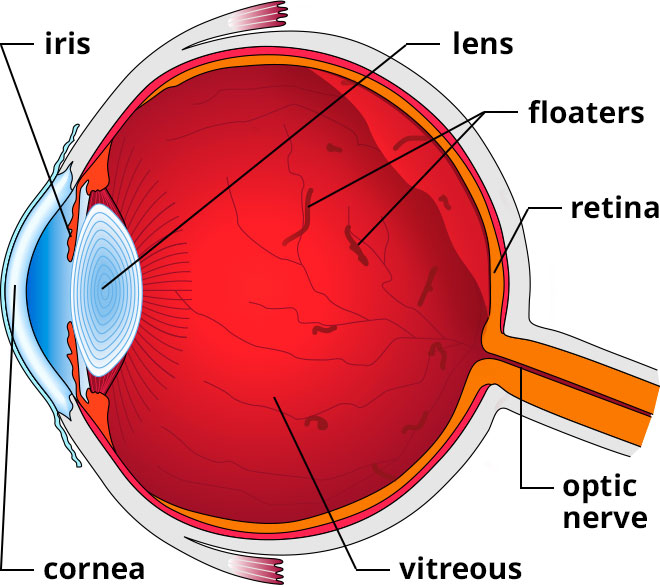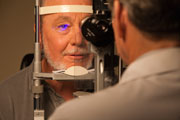Floaters and Flashes
What Are Floaters and Flashes?
You may sometimes see small specks or clouds moving in your field of vision. These are called floaters. You can often see them when looking at a plain background, like a blank wall or blue sky. Floaters are actually tiny clumps of cells or material inside the vitreous, the clear, gel-like fluid that fills the inside of your eye.

Floaters shown in the
vitreous gel
Causes of Floaters and Flashes
As we grow older, it is more common to experience floaters and flashes. When people reach middle age, the vitreous gel may start to shrink, forming clumps or strands inside the eye. The vitreous gel pulls away from the back wall of the eye, causing a posterior vitreous detachment. This is a common cause of floaters.
Floaters and flashes are also caused by posterior vitreous detachment, where the vitreous gel pulls away from the back of the eye. This condition is more common in people who:
• Are nearsighted;
• Have undergone cataract operations;
• Have had YAG laser surgery of the eye;
• Have had inflammation (swelling) inside the eye.
• Have had an injury to the eye.
The appearance of floaters and flashes may be alarming, especially if they develop very suddenly. To find out if a retinal tear or detachment is occurring, you should call your ophthalmologist right away if you notice the following symptoms, especially if you are over 45 years of age, have had an injury to your eyes or head, or if you have substantial nearsightedness:
- A sudden increase in size and number of floaters
- A sudden appearance of flashes
- Having a shadow or curtain appear in the periphery (side) of your field of vision
- Seeing a gray curtain moving across your field of vision
- Having a sudden decrease in your vision

Vitreous detachment
Floaters and flashes symptoms
Symptoms of vitreous floaters include seeing small specks or clouds moving in your field of vision, or seeing dots, circles, lines or "cobwebs." Symptoms of flashes include seeing flashes of light or seeing "stars."
If the vitreous gel shrinks and pulls away from the wall of the eye, the retina can tear. This sometimes causes bleeding inside the eye that may appear as new floaters.

A torn retina is always a serious problem, since it can lead to retinal detachment. You should see your ophthalmologist (Eye M.D.) as soon as possible if you suddenly see an increase in the size and number of floaters, and/or you suddenly see flashes of light.
Some people experience flashes of light that appear as jagged lines or "heat waves" in both eyes, often lasting 10 to 20 minutes. These are not flashes from the vitreous gel pulling on the retina; instead, these types of flashes are usually caused by a spasm of blood vessels in the brain, called a migraine. If a headache follows the flashes, it is called a migraine headache. However, jagged lines or heat waves can occur without a headache. In this case, the light flashes are called an ophthalmic migraine, or migraine without headache. Contact your ophthalmologist if you experience these symptoms.
If you notice other symptoms, like the loss of side vision, you should see your ophthalmologist.
When Are Eye Floaters and Flashes a Medical Emergency?
If you see a shower of floaters and spots, sometimes accompanied by light flashes, you should seek medical attention immediately.
The sudden appearance of these symptoms could mean that the vitreous is pulling away from your retina or that the retina itself is becoming dislodged from the inner back of the eye that contains blood, nutrients and oxygen vital to healthy function. When the retina is torn, vitreous can invade the opening and push out the retina — leading to a detachment.

For some people, floaters are clumpy; for others, they're stringy. They may be light or dark. What you see is actually the shadows cast by clumps of vitreous gel when light shines past them onto the retina. (If you can't see the image, you may need Flash Player.)
A study reported in the Journal of the American Medical Associationin 2009 found that sudden presence of eye floaters and flashes means that one in seven people with these symptoms will have a retinal tear or detachment.
And up to 50 percent of people with a retinal tear will have a subsequent detachment.
In cases of retinal tear or detachment, action must be taken as soon as possible so that an eye surgeon can reattach the retina and restore function before vision is lost permanently.
Posterior vitreous detachments (PVDs) are far more common than retinal detachments and often are not an emergency even when floaters appear suddenly. But some vitreous detachments also can damage the retina by tugging on it, leading to a tear or detachment.
Light flashes known as photopsia can occur when your retina receives non-visual (mechanical) stimulation, which can happen when it is being tugged, torn or detached.
Floaters and Flashes Diagnosis
Vitreous floaters and flashes become more common as we grow older. However, while not all floaters and flashes are serious, you should always have a medical eye examination by an ophthalmologist to make sure there has been no damage to your retina.

When an ophthalmologist examines your eyes, your pupils may be dilated (enlarged) with eyedrops. During this painless examination, your ophthalmologist will carefully observe areas of your eye, including the retina and vitreous. If your eyes have been dilated, you will need to make arrangements for someone to drive you home afterward.
Floaters and Flashes Treatment
Vitreous floaters may be a symptom of a tear in the retina, which is a serious problem. If a retinal tear is not treated, the retina may detach from the back of the eye. The only treatments for a detached retina are a laser procedure or surgery.

Other floaters are harmless and fade over time or become less bothersome, requiring no treatment. Surgery to remove floaters is almost never required. Vitamin therapy will not cause floaters to disappear.
Even if you have had floaters for years, you should schedule an eye examination with your ophthalmologist if you notice a sudden increase in the size or amount of floaters or a sudden appearance of light flashes — especially if these symptoms are accompanied by any change in your vision.
Know your risks. Save your sight.
The American Academy of Ophthalmology recommends that adults with no signs or risk factors for eye disease get a baseline eye disease screening at age 40 — the time when early signs of disease and changes in vision may start to occur. Based on the results of the initial screening, an ophthalmologist will prescribe the necessary intervals for follow-up exams.
For individuals at any age with symptoms of or at risk for eye disease, such as those with a family history of eye disease, diabetes or high blood pressure, the Academy recommends that individuals see their ophthalmologist to determine how frequently their eyes should be examined.
Other floaters are harmless and fade over time or become less bothersome, requiring no treatment. Surgery to remove floaters is almost never required. Vitamin therapy will not cause floaters to disappear.
Even if you have had floaters for years, you should schedule an eye examination with your ophthalmologist if you notice a sudden increase in the size or amount of floaters or a sudden appearance of light flashes — especially if these symptoms are accompanied by any change in your vision.
Know your risks. Save your sight.
The American Academy of Ophthalmology recommends that adults with no signs or risk factors for eye disease get a baseline eye disease screening at age 40 — the time when early signs of disease and changes in vision may start to occur. Based on the results of the initial screening, an ophthalmologist will prescribe the necessary intervals for follow-up exams.
For individuals at any age with symptoms of or at risk for eye disease, such as those with a family history of eye disease, diabetes or high blood pressure, the Academy recommends that individuals see their ophthalmologist to determine how frequently their eyes should be examined.
You can always contact our customer service team over the phone on +6019 2877 766 or email your enquries to info@vfocusvisiononline.com.my, and they’ll be happy to assist you. Kindly visit our website vfocusvisiononline.com.my to check our available retail store.